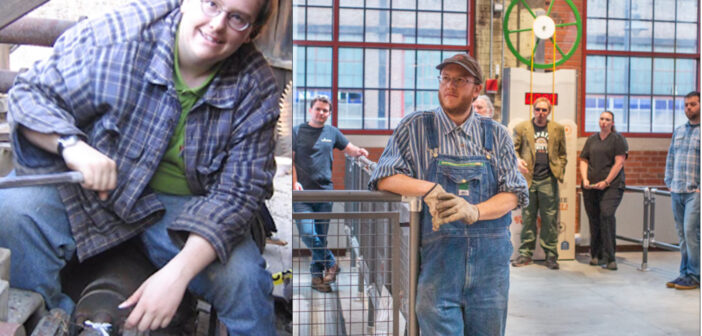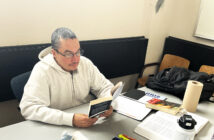On his second day of college, Mike Piersa, ‘08G, walked into the National Museum of Industrial History to pursue a volunteering opportunity.
Piersa, a Moravian University undergraduate student at the time, stayed in Bethlehem and continued volunteering at the museum throughout the duration of his master’s program at Lehigh.
His love for history led him to pursue a master’s degree in history and political science, with a focus on industrial history.
Today, he is the museum’s historian and specialist. Piersa helps this team with research; guides specialized tours; and plans events, demonstrations and exhibitions.
He reminisced on a time when the vacant space was only the ruins of the Bethlehem Steel Corporation.
“The actual museum building was a shell with broken windows, a gravel floor, and we were trying to raise the money, gather artifacts and raise awareness about it,” he said. “There was a lot of work that went on for years and years well before we opened.”
In 1857, the Bethlehem Steel Corporation was established.
It quickly became one of the largest steel producing companies in the world, attracting laborers from all over seeking jobs in the steel industry. At its peak, the Bethlehem Steel Corporation employed over 30,000 workers.
In 2003, the Bethlehem Steel Corporation closed down after declaring bankruptcy. When the plant knew that it would be closing, they did not want to leave their buildings vacant.
Instead, they started planning.
In 2016, the Bethlehem Steel Corporation worked with Bethlehem Works to redevelop the site. They teamed up with the Smithsonian to create an affiliate of the museum within Bethlehem, which is now known as the National Museum of Industrial History.

The National Museum of Industrial History is located on East Second Street in South Bethlehem. The museum opened in 2016. (NMIH/Glenn Koehler)
Andria Zaia is a part of the curatorial team at the museum, a group dedicated to highlighting the history of the Bethlehem Steel Corporation.
Zaia said she has worked at museums since she was about 12 years old, volunteering initially, and then in paid positions after her schooling.
Zaia comes from a Bethlehem Steel family.
“My grandfather worked (at the Bethlehem Steel Corporation), my father worked here for over 40 years, my uncle worked here and even my oldest brother worked here for a couple of years,” she said.
As a curator, Zaia works with objects and artifacts that come into both temporary exhibitions and permanent collections.
She works closely with the team to schedule, design and install consistently changing exhibits. The team also includes a collections manager and a coordinator.
Emily Marchello is the collections manager for the museum. She started her journey as an intern in December of 2015, before the museum opened its doors in August of 2016.
She joined the collections department six months after opening and has been there since.
“A lot of people come down here expecting to just see steel because we are on the historic Bethlehem Steel site,” Marchello said. “I wish more people knew about and understood how industrial history still affects our lives today.”
Marchello said she feels as though people think industry has died in America. She hopes to spread awareness about the history of Bethlehem Steel through the exhibits on display at the museum.
“Something that we’re really trying to get people to understand is that industry in America is alive and well,” Marchello said. “It’s changed. It’s shifted, so it looks a bit different than it did before. But we’re still representing the workforce here.”
The museum recently launched a self-guided walking tour that can be accessed on a mobile device. By scanning a QR code at the museum, visitors can learn more about the history of the Bethlehem Steel Corporation.
One of the current exhibitions is centered on the early days of the Bethlehem plant. This exhibit highlights the history of the Bethlehem Iron Company, Bethlehem Steel’s predecessor.
The museum is also home to permanent galleries, such as an iron and steel gallery inside the main exhibition hall. The team works with Bethlehem Steel Corporation archival material that workers saved from their time working in the factory.
“That’s a really fun part of our job,” Zaia said. “We also work with former Bethlehem Steel employees who do some volunteering with us, and it’s just incredible to listen to their stories.”
Education and programs coordinator Katie Rymon works on public programming and organizing field trips, in addition to leading tours as a museum educator.
She said her favorite part of the job is the people, including the former Bethlehem Steel Corporation employees.
“Their depth of knowledge is just astounding for the industry and for the area,” Rymon said. “I learn something new every day when I go in.”
Rymon said she wishes more people knew about the family-friendly aspect of the museum.
Every Sunday, kids ages 12 and under get free admission when accompanied by an adult. Starting next month, the museum will offer hands-on activities for children of all ages on the third Sunday of every month.
“People think, ‘The National Museum of Industrial History? That can’t be for everyone. That must be for a really niche market,’” Rymon said. “And it’s not. Industrial history is everybody’s history.”
Piersa said something he thinks people do not know about the museum is that they can be a part of it.
The museum is constantly accepting new volunteers to join the team. They accept volunteers of all ages and are flexible with time commitments — some volunteers come once a week, some a few times a year.
“Coming here doesn’t have to be a life-altering commitment, but sometimes it ends up being like that,” Piersa said.
More information about the National Museum of Industrial History and volunteer opportunities can be found on their website.






Comment policy
Comments posted to The Brown and White website are reviewed by a moderator before being approved. Incendiary speech or harassing language, including comments targeted at individuals, may be deemed unacceptable and not published. Spam and other soliciting will also be declined.
The Brown and White also reserves the right to not publish entirely anonymous comments.